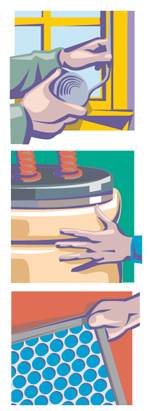
Winter proofing your home
By on Jun 19, 2008

As GTA residents, we're accustomed to long
Canadian winters and the changes in lifestyle
they bring. Whether it's purchasing wintertires, warm clothing, or tickets to Florida, each of us
personally prepares for the season. And while havingyour scarf and toque will certainly help you survive the
cold, Ontarians, and homeowners in particular, have moreto worry about.
Come autumn's end, winter-proofing your residence
should be a top priority. Adequate preparation from the
cold will reduce potential damage, keep your homecomfortable, and save you significant costs in energy bills.
Many important steps are involved in fully preparing
your home for winter. Of these steps, sealing your homeis the most cost-effective and efficient approach. Proper
sealing eliminates common problems such as increasedgas and energy bills, cold drafts entering the home,
and moisture issues, which are potentially damaging towallpaper, furniture, and windows. Energy Star, a leader
in energy efficiency, has outlined the more importantconsiderations when sealing your home:
- Insulate your attic hatch to prevent warm air escaping
from the top of your home.
- Seal any holes, whether they're electrical or plumbing
related, that lead from the attic to the house.
- Use spray foam in areas where pipes, wires, and vents
exit the walls. Be sure to check underneath sinks as well.
- Use colour-matched latex caulk for door and window
frames and use a stronger version for exterior purposes.
- Use foam gaskets around electrical outlets to reduce
drafts.
Home sealing reinforces the skeleton of your home
to prevent cold air from entering and warm air fromescaping. However, well-informed individuals will also
take the time to prepare major appliances and utilities.This is a vital process that will have a huge impact on
monthly bills and preventing unnecessary maintenanceexpenditures. Here's more Energy Star advice:
- Replace your furnace's air filter before the heating
season begins. A dirty filter will reduce air flow, which
makes your system work harder. Cover the filter slot
with a piece of wide tape to keep air from getting inaround filter edges without passing through the filter.
- If your furnace or boiler is more than 15 years old,
consider Energy Star-qualified replacements. New
equipment has advanced technology to deliver higherefficiency, which will deliver the greatest savings.

- Make sure your ducts are delivering all the warm air they
can. If seams are visible where your ducts adjoin, seal
them with shiny foil tape with a UL-181 label or duct
mastic (also called duct sealant). - If you have ducts that run into the attic or through a cold basement or crawl space, be sure they're well insulated.
- Set back your thermostat when you're asleep or away.
When used properly, an Energy Star programmable
thermostat with temperature and time settings can save
you $100 per year on energy costs. - Call a heating contractor to service your system. Fall is a
great time for a technician to check that your heating
system is running properly to keep you warm without
adding unnecessary costs.
The cold months can be a trying time, but with
adequate preparation, you can significantly reduce the
stress of high bills. Be prepared and you won't regret it.
To learn more about Energy Star or discover
other valuable tips for winter-proofing your home, visit
www.energystar.gov today.
Look for part 2 of our winterizing tips in an upcoming
issue of NDHC.


